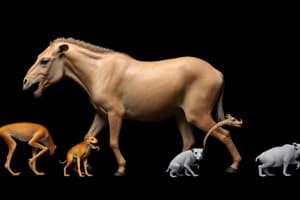Podcast
Questions and Answers
What is the estimated number of animal species in total?
What is the estimated number of animal species in total?
- 1 million
- 10 million
- 7.77 million (correct)
- 2.16 million
Which is the oldest animal phylum that lacks complex organization and distinct tissues?
Which is the oldest animal phylum that lacks complex organization and distinct tissues?
- Cnidaria
- Bilateria
- Ctenophora
- Sponges (correct)
What are the characteristics that set animals apart from other living things?
What are the characteristics that set animals apart from other living things?
- Being heterotrophic and motile (correct)
- Being heterotrophic and immobile
- Being autotrophic and immobile
- Being autotrophic and motile
What is the name of the clade whose members have a bilaterally symmetric body plan?
What is the name of the clade whose members have a bilaterally symmetric body plan?
Which phyla have radial symmetry and a single digestive chamber, but distinct tissues are not organized into organs?
Which phyla have radial symmetry and a single digestive chamber, but distinct tissues are not organized into organs?
What is the name of the protostomes that grow via moulting and include arthropods, roundworms, and other small phyla?
What is the name of the protostomes that grow via moulting and include arthropods, roundworms, and other small phyla?
What is the name of the protostomes that develop via spiral cleavage and include the Lophotrochozoa and Platytrochozoa?
What is the name of the protostomes that develop via spiral cleavage and include the Lophotrochozoa and Platytrochozoa?
What is the name of the hierarchical biological classification for animals created by Carl Linnaeus in 1758?
What is the name of the hierarchical biological classification for animals created by Carl Linnaeus in 1758?
What is the name of the animal kingdom's sister group, with which they form the Choanozoa?
What is the name of the animal kingdom's sister group, with which they form the Choanozoa?
Flashcards
What are animals?
What are animals?
Animals are multicellular organisms belonging to the kingdom Animalia. They are heterotrophic, meaning they obtain nutrition by consuming other organisms.
What are some characteristics of animals?
What are some characteristics of animals?
Animals are diverse in size, ranging from microscopic organisms to massive whales. The majority of animal species are bilaterally symmetrical, meaning they have a left and right side.
How did animals evolve?
How did animals evolve?
The evolution of animals is a fascinating story, starting in the oceans and eventually leading to diverse forms on land. Animals are believed to have originated from a common ancestor, making them a monophyletic group.
What are the simplest animal groups?
What are the simplest animal groups?
Signup and view all the flashcards
What are bilateria animals?
What are bilateria animals?
Signup and view all the flashcards
What are protostomes and deuterostomes?
What are protostomes and deuterostomes?
Signup and view all the flashcards
What are ecdysozoans?
What are ecdysozoans?
Signup and view all the flashcards
What are spiralia?
What are spiralia?
Signup and view all the flashcards
What is the significance of animals to humans?
What is the significance of animals to humans?
Signup and view all the flashcards
Study Notes
Kingdom of Living Things:
-
Animals are multicellular, eukaryotic organisms in the biological kingdom Animalia.
-
As of 2022, 2.16 million living animal species have been described, but it has been estimated there are around 7.77 million animal species in total.
-
Animals range in length from 8.5 micrometres (0.00033 in) to 33.6 metres (110 ft).
-
Most living animal species are in Bilateria, a clade whose members have a bilaterally symmetric body plan.
-
Historically, Aristotle divided animals into those with blood and those without.
-
Carl Linnaeus created the first hierarchical biological classification for animals in 1758 with his Systema Naturae.
-
Animals have several characteristics that set them apart from other living things, such as being heterotrophic and motile.
-
All animals are composed of cells, surrounded by a characteristic extracellular matrix composed of collagen and elastic glycoproteins.
-
Nearly all animals make use of some form of sexual reproduction.
-
Animals are categorised into ecological groups depending on how they obtain or consume organic material.
-
Animals originally evolved in the sea, and lineages of arthropods colonised land around the same time as land plants.
-
Animals are monophyletic, meaning they are derived from a common ancestor, and are sister to the Choanoflagellata, with which they form the Choanozoa.Animal Classification Summary
-
Sponges are the oldest animal phylum and lack complex organization and distinct tissues.
-
Ctenophora and Cnidaria have radial symmetry and a single digestive chamber, but distinct tissues are not organized into organs.
-
Bilateria animals have bilateral symmetry, three germ layers, and a complete digestive tract with a mouth and anus.
-
Bilateria animals have a head end, tail end, back surface, belly surface, and a left and right side.
-
Protostomes and deuterostomes differ in embryonic development, mesoderm formation, and digestive tract development.
-
The Ecdysozoa are protostomes that grow via moulting and include arthropods, roundworms, and other small phyla.
-
The Spiralia are protostomes that develop via spiral cleavage and include the Lophotrochozoa and Platytrochozoa.
-
The Lophotrochozoa include molluscs, annelids, brachiopods, nemerteans, bryozoa, and entoprocts.
-
Aristotle divided animals into those with and without blood and arranged them on a scale from man to spontaneously generating creatures like sponges.
-
Carl Linnaeus created the first hierarchical classification in his Systema Naturae.
-
Animals are exploited for food, textiles, medicine, and experimental models.
-
Animals have been the subjects of art, literature, film, mythology, and religion throughout history.
Studying That Suits You
Use AI to generate personalized quizzes and flashcards to suit your learning preferences.




